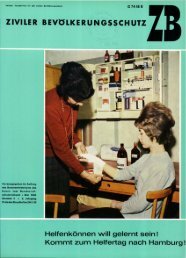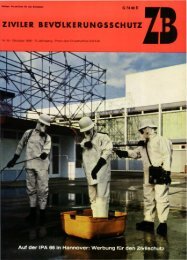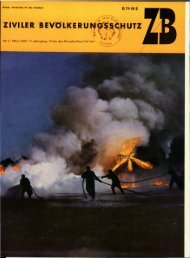Zivilschutz- Forschung - Bundesverwaltungsamt
Zivilschutz- Forschung - Bundesverwaltungsamt
Zivilschutz- Forschung - Bundesverwaltungsamt
Erfolgreiche ePaper selbst erstellen
Machen Sie aus Ihren PDF Publikationen ein blätterbares Flipbook mit unserer einzigartigen Google optimierten e-Paper Software.
183. US Army Medical Research Institute of Chemical Defense (2000): „Field<br />
Mangement of chemical casualties“<br />
184. US Army (2001): „The medical NBC-Battlebook“<br />
185. US Army, Zajtuk, R (1997): „Textbook of military medicine“<br />
186. Usher, A. (1979). „The Flixborough disaster.“ Med Leg J 47(3): 84-102.<br />
187. Venart, J. E. (2000). „'Root' cause of the Flixbourgh Disaster 1974.“ J Hazard<br />
Mater 80(1-3): 271-2.<br />
188. Vijayan, V. K. and K. Sankaran (1996). „Relationship between lung inflammation,<br />
changes in lung function and severity of exposure in victims of the<br />
Bhopal tragedy.“ Eur Respir J 9(10): 1977-82.<br />
189. Vikelsoe, J. and E. Johansen (2000). „Estimation of dioxin emission from<br />
fires in chemicals.“ Chemosphere 40(2): 165-75.<br />
190. Waeckerle, J. F. (2000). „Domestic preparedness for events involving<br />
weapons of mass destruction.“ Jama 283(2): 252-4.<br />
191. Wagner, G. N., M. A. Clark, et al. (1988). „Medical evaluation of the victims<br />
of the 1986 Lake Nyos disaster.“ J Forensic Sci 33(4): 899-909.<br />
192. Waterworth, T. A. and M. J. Carr (1975). „Report on injuries sustained by<br />
patients treated at the Birmingham General Hospital following the recent<br />
bomb explosions.“ Br Med J 2(5961): 25-7.<br />
193. Weill, H. (1987). „Disaster at Bhopal: the accident, early findings and respiratory<br />
health outlook in those injured.“ Bull Eur Physiopathol Respir 23(6):<br />
587-90.<br />
194. Weisman, R. S., L. Goldfrank, et al. (1985). „Chemical disasters.“ Vet Hum<br />
Toxicol 27(5): 439.<br />
195. Wetter, D. C., W. E. Daniell, et al. (2001). „Hospital preparedness for victims<br />
of chemical or biological terrorism.“ Am J Public Health 91(5): 710-6.<br />
196. Wheeler, H. (1998). „Major incident planning particularly those including<br />
chemicals.“ Emerg Nurse 6(1): 12-6.<br />
197. Woodall, J. (1997). „Tokyo subway gas attack.“ Lancet 350(9073): 296.<br />
198. Woudenberg, F. and P. van der Torn (1992). „Emergency exposure limits: a<br />
guide to quality assurance and safety.“ Qual Assur 1(4): 249-93.<br />
199. Xiao, J., B. R. Cai, et al. (1993). „Specificity and treatment of thermal and<br />
inhalation injury following an explosion in a cement manufacturing kiln.“<br />
Burns 19(3): 232-4.<br />
200. Zeigler, J. P. (1996). „The dangers of chemical weapons.“ Occup Health Saf<br />
65(10): 182-6.<br />
201. Wenke, R., Helms E. „Dekontamination von Verletzten.“ Rescue 1999 und<br />
2002<br />
232

















